Sometimes some people leave a trail of influence behind them, that can be in the cars they build, the photography they create, or the way they connect with others. Someone who comes along who maybe causes a stir, but all for the better or maybe worse. I'd say there are a few people in the world who can use the word ‘influencer’ organically. Let that be in either film, sports, technology or other subjects. Mike from the car community can slot into that description.
It’s been a few years since I met Mike at the Stanceworks shop in SoCal. From reading the forum posts on Rusty and the occasional message over the internet, I was 5000 miles from home having a chat while watching what antics he and his close friends were up to. Back then, he was building the Model A.

Please bear with me, this is a long story I’ve wanted to tell for a long time now, and it is worth it. Unfortunately, plans to return to SoCal and hang out with Mike and friends again got delayed a few extra years, no thanks to Covid, so I’m glad the Model A stuck around. I planned to return to laying eyes on the ‘final’ running project before even thinking of writing this piece on Mike. I've now come to a realisation I need at least a 3rd or even 4th visit now to fully tell all these stories.
But before we get started in story time for one of his many builds, I shall backtrack a touch. Long before the days of Instagram and the intro of social media to the ‘car scene’. We shall start with Mike himself. We all have this different story in our introduction to cars. Looking back over the past 10+ years of what Mike has achieved, you’d probably think he was influenced a very young age and always had this passion for cars of all subjects. But the truth is quite far from this. A slightly more boring story. As Mike grew up he didn’t have this mechanical itch, the longing for driving a car or building his own. The start came around the time leading up to thinking about getting his driver's license. It was then that Mike started to take an interest in what car he would like to own first.
His story is interesting, as his Dad is very much into cars through and through. Having a series of car builds and magazine features, it just wasn’t something they shared. But looking at it now, the apple hasn’t fallen far from the tree.

Mike's first car came to be a ‘97 Chevy S10, which he saw up for sale near his school. With a subwoofer behind the seats, those seat belt pads giving the race car vibe and bright orange underglow, to 16-year-old Mike it was the coolest. A visit with his parents and a deal were upon agreed. Mike says looking back, the underglow phase was something he luckily grew out of very quickly, which I feel is unfortunate. We can agree to disagree that underglow is still cool today.
It took a while before Mike started to play around with cars. Not until he saw a Calypso Red E30 with an M50 swap and Ronal LS wheels. This car sparked something BMW related in him. It took him from looking at these older BMWs and thinking that they were just 'old man cars' for people who hadn’t decided to upgrade, to a car that could be considered cool.
After this revelation, he managed to pick up a $250 cheap E30. It needed a bunch of work that Mike taught himself with help from friends and created his first little project if you could call it that. The universe had other ideas for this car and someone decided they’d plough right into the rear end writing it off. The silver lining to this story is the money the insurance paid out would help the purchase of a car that a lot of you will think of when someone says, Mike Burroughs. His famous E36. The 36 is up there being one of the early ones in a way leading by example. It's great to see that 15 years on, even after a few neglected years, Mike has turned some attention to it and brought it back on the road.
I recently learnt that in this timeframe Mike also owned for a short stint an ‘89 Honda Prelude, which now makes sense as to why he took such a liking to Jon Lawrence's Prelude posted from Wheel Pros open day and Retro Rides back in 2021.

Forums were the big thing around this time. The Bimmer forums consumed and took over his life. From the early age of 16, constantly reading others' build threads and eventually posting his own. Grabbing ideas and learning how to do so much from them, it was a great time to be into cars. The level of detail you could gain, compared to what we have now with Instagram was a time that's missed, maybe in a sense of nostalgia, but that's an entirely different conversion.
As Mike started to modify, slamming BMWs and stretching tyres like the Volkswagen community had been doing for a while. It was still a relatively new thing for the BMW community and started to cause an upset in the force and became a subject of bickering and arguments for no reason, causing Mike to slowly pull away which lead to the creation of Stanceworks.

Stanceworks was built on a foundation as a forum, taking a gap in-between current ones where like-minded people, of all manufacturers, had a space to share their cars, away from the toxic environment that was steadily building. The popularity increased, and as Mike would travel about the US taking photos, the blog side of Stanceworks came to be and took off. Not only is Mike a great builder and fabricator, inspiring people to build what they desire, but he’s also done the same in the photography and writing side of the “scene”. Having a distinct editing style to his images, when you see them, you instantly know they’re Mike’s.

As Stanceworks has grown, so has the type of content that Mike’s produced. The meaning of the word ‘stance’ can be a tricky one these days. When we tend to think of stance we think of very low, out there kinds of cars. People in the early days would look past the Stance in Stanceworks and think of only that style, but further down its timeline, if you take a step back from just that part of the car community, Mike has crafted a place where he can show anything that he and close friends just think of as cool. Stance has become, and always really has been a lot more than just a car lowest to the ground as possible with silly sized and cambered wheels. To my eyes “stance” can have a meaning anywhere in the motor industry. For the last decade, Mike has covered so many different styles, hundreds of pages and features showcasing cool car after cool car letting him present his broad taste in all things on-road, off-road, 2 wheels and 4. Classic to new and road to race. There's content out there for everyone.

In regards to Stancworks as a whole, for everything that's been on the site, Mike is very proud of what he and his close friends have created. It hasn't been an easy ride. It was the decision after the Rusty fire, to move from Tennessee to California that was the turning point for Mike and his friends, Andrew and Ben. It was a tough transition, one getting ready for the move and secondly finally being there. Living out of the warehouse they rented, eating cheap and not doing a lot apart from building cars. It took about 2 years before they saw any kind of liveable paycheck. But it all helped them with their vision for Stanceworks and them being their own bosses.
Mike has used Stanceworks to guide and help the community go a certain way for hopefully the better instead of just moaning about the negatives and like a few other brands and blogs, Mike and his friends have succeeded well in the past decade.
Social Media has taken a stronghold on the way car culture is now consumed by the masses. Mike's thoughts are similar to my own, thinking about the way car culture can still be enjoyed. Yes, there are long hours in photography and spending hours planning and writing features. But we both still love telling a person or car's story, and the blog side of Stanceworks and Rollhard is something that won’t be going away anytime soon. It’s not something that’s done for a paycheck, but the hecking love of doing so and to give something back to the car community. So much depth can go into a build, they deserve the minute attention to detail and as readers it's important to come across these, share ideas and even learn along the way. A thank you goes out to all the dedicated readers of the blogs all over the internet.

Now if we're talking about Mike Burroughs, Rusty Slammington is always going to be a topic of discussion. Rusty is a car that needs its own post and so much more. The story he's had over the past 10+ years is one worth telling and waiting for. Rusty is a car with so much more than getting covered in rust and eventually turning into a Silhouette Group 5 styled tube chassis masterpiece after burning down in a garage fire. A truly different aspect of a BMW art car.
I'm still yet to get Rusty behind the lenses of my camera, but once I will, the story of how I witnessed it will be told, there's no rush, I've waited long enough, I can wait a little more.
Rusty plays a part in the build of the 'new' Model A along with a car Mike owes a lot to, his first hot-rod, a '28 Model A. The '28 was built just as he moved to SoCal. A build is full of firsts and major milestones. Learning many fabrication skills and becoming a competent welder. Before moving to SoCal, but after the fire. Mike had a friend Chuck, who worked at a shop that built tube chassis drag cars. This is where the idea of rebuilding Rusty with a tube chassis came from. Mike would help out once a week at the shop, watching and learning so one day he could build his own chassis.
Rusty’s front suspension was all Mike's design, teaching him all about roll centres, instant centres, anti-dive and much more. What he learned in those two builds alone, set him up for success with the '31 Model A
Rusty and the E36 may be the main reason from the earlier days why he's known so well. But there are a few other outstanding and recognisable cars over the years he's produced. I can't forget the beautiful BMW E9 Mike had for a while, bagged, low and on HRE wheels, to showcase their new 501 classic range. What was created was a clean old look with lots of styles, most that were actually straight from the factory. A great example that less is more.
There was also the Group A E28 tribute parts car. BMW has such a rich and fulfilling Motorsport history and inspired Mike to celebrate that in a build. Only about 20 of these were built and raced to FIA group A standards and Mike went on to build something true and in spirit. Right down to getting hold of the 1982 FIA rulebook.

Shall we get to the car I visited to see and photograph? This is Mike's ‘31 Ford Model A classic hotrod, road racing, trophy truck contraption or what other names you want to call it. It life started as a fully running, fully fendered stock Model A. The guy selling it had owned it for a good 15 years, keeping it in relatively great running condition, especially for a car from the 30s. The two of them struck up a deal even with Mike saying he wouldn’t be cutting it up and not long later it was paid for and at the shop. This Model A was the second one Mike had come across. He was days away from buying another clean example located in Minnesota but the owner opted to wait the weekend before taking payment. That Sunday, Mike went along to the Pomona Swap meet and came across the Model A we all know today.
The story of this car predates the purchase. This was something Mike was building for himself. To create a vision and learn new skills like with the '28 rod and Rusty. From the get-go, Mike also knew the truck would be being built for SEMA, so no pressure. Mike has a very strong relationship with Roland from H&R Springs and with help from Andrew, talking through countless ideas and coming up with a vision he wanted to build, he pitched to Roland the idea for the truck and that H&R could build the coilovers. With the success of Rusty at SEMA in 2015, Mike had a spot on the H&R Booth.

Now, to call the truck a free ride with it being built for SEMA, would be a very untrue thing to say. Yes, some cars are built for the show using as many free parts as possible to keep costs low and the parts arriving to be fitted but I like Mike's philosophy on how he went about the truck. Mike likes to keep integrity with the build as a whole and would ask himself the question, "Would I still use the part and pay full price?" Don't get me wrong, Building a car with the knowledge that it would be at SEMA does open a lot of doors, and Mike had a few companies who would be able to help out and believe in his ideas, but from having a long, long chat as we sat down on the truck's tires, it still cost Mike a pretty penny.

The Model A was purchased in April of 2018. So 5 and a half long hard months Mike and his friends had to build this car ready for the show. But this wasn’t something that put doubt into his mind. With the first Model A he built and Rusty’s re-Imagineering, lots had been learnt, so the timeline was just another simple factor to think of making sure it was built in time.

Back in September 2018, the first time I saw the truck. It was in a mid-build phase. The IMSA Motegis was lying on the floor. Khalil, Miller and Mike were installing the supercharger and fiddling with other small parts. Going back to talking about lessons involving Rusty. It’s the little things that crop up over the build, especially near the end that could delay creating issues. Every major component needs to have a bracket, and with custom builds like this one, that has to be designed and built. Small ideas may not even exist in an "off the shelf" way, so hurdle after hurdle can be thrown at you. One strong memory of that 2018 visit was the installation of the pedal reservoirs. Mike had a specifically thought out location for them being below the windscreen under a panel that could flap open for easy access. The issue here was one of the reservoirs was too tall to fit under the panel as it curved downwards towards the edge. Buying a smaller one or cutting up and re-sealing was going to be a bigger job for such a small issue and cutting the panel or making a bulge was a no go for the vision Mike had of the cab looking pretty much as stock as could be. In the end, the screw cap and thread were filed down the 10 odd millimetres so it fit super snug under that panel. This was only a 15 minute delay in the installation of one part, but all those little 15 minutes can add up quickly.
It was purely built outside of work hours. Every afternoon setting up camp in the shop and working till the sun dropped behind the back of the building. As time did move on, more and more of the day was taken over the building. For the closing 2 months, every spare second was utilized and as Mike entered the final 2 weeks Mike pushed all responsibilities aside and worked full time making sure the truck was ready for SEMA.

Mike only kept a handful of original parts, selling off everything he didn’t need to other Model A enthusiasts, so in the chopping up of a running car, Mike promised he wouldn't chop up, you could say he helped a few more Model A's gets closer to being back on the road.

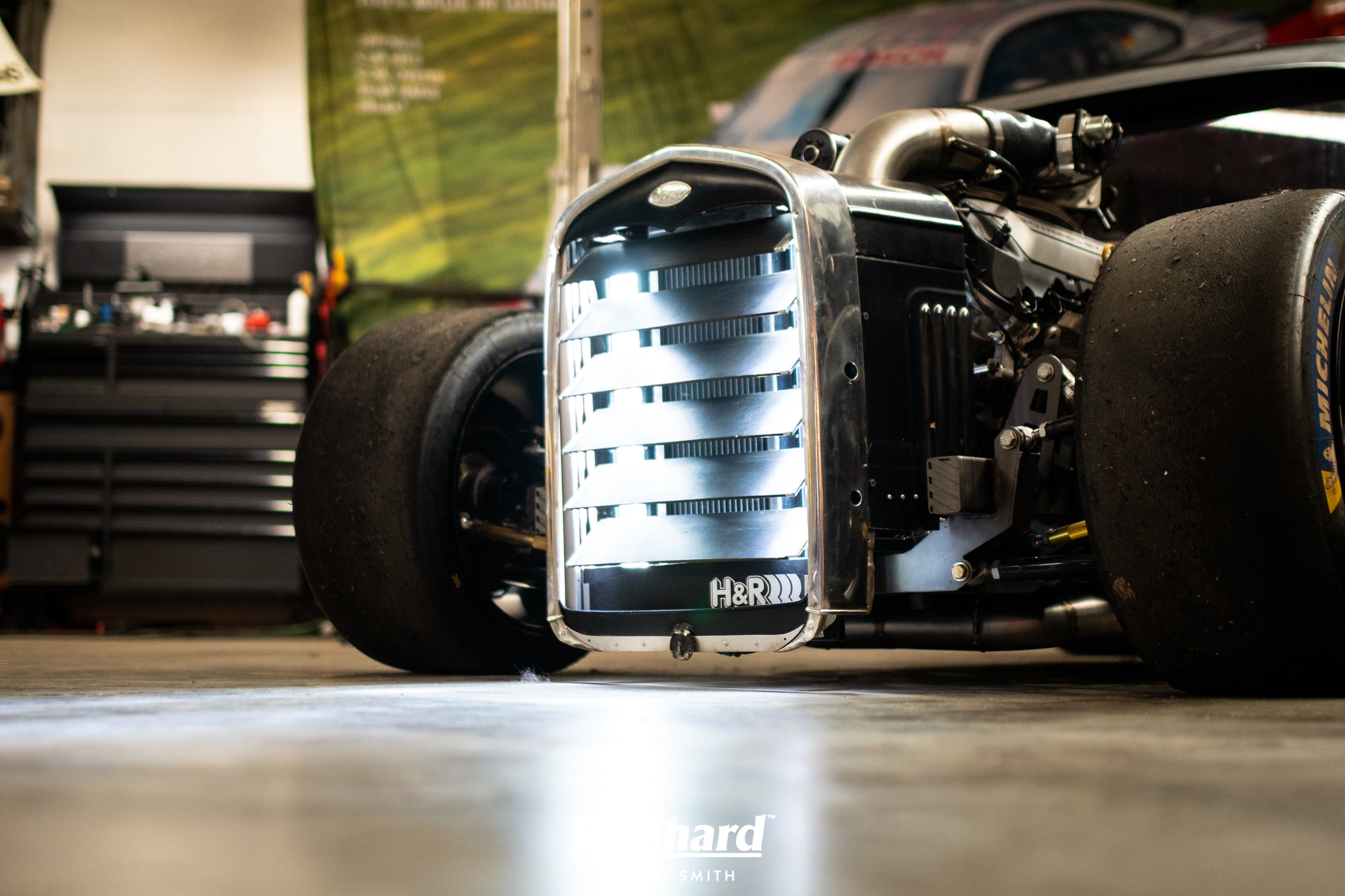
Keeping the cab as original as possible was a desired aspect of the truck build. It only had a light chop of 3 inches. Still retains the pop-out front windscreen and winding door windows. Other parts Mike kept so it still resembles a Model A at best were the original grill shell and front 8 inches of the hood. Inside the grill shell, there is a custom louver setup which opens up for the headlights, intercooler and heat exchange for the blower.

With the cab and front grill, the only original parts Mike got to work building a chassis. The base chassis was built using 2 by 3 120 wall tubing and a typical Z'd frame front and rear to keep the body low but not sacrifice too much on suspension geometry. The cage structure uses 1 and 3/4 120 tubing to give extra stability. Tubes run around the cab and tie into the suspension pickup points for overall support. The truck has no flex and pretty much drives as described by Mike, "like a go-kart". Also, the cage structure was built with the unmissable Trophy Truck influence. The entire chassis and cage are just spray painted to give it a cleaner look.

For the heart of the truck, keeping this build as much Ford as possible was the idea. The first engine I originally saw having the blower fitted to was a first-gen Coyote engine out of a 2011 Mustang Mike picked up from a wrecked car. A 2.65-litre 3rd-generation VMP twin-screw supercharger was attached on top connected by an 85mm pulling and other supporting mods. This was a company Mike reached out to say he wanted to use their product and would they be interested in working together. As said, this was not a free part by all means. On completion, the truck was running at around 14psi on E85 with a butt-dyno figure, with 800bhp in mind. Madness for a truck weighing 2200lbs.
This truck is unlike anything he’s driven before. For how quick a car can be, this does not run through the rpm band, it blasts through it and the tires are constantly struggling to keep up with that.

Well, the Gen 1 Coyote went bang after not many miles. Fast forward 18 months, Mike ended up in a position of needing another engine quickly. Ford Motorsport sell a crate motor, called an "Illuminator", which is a 5-litre Coyote with truly forged internals and a forged steel crankshaft that is purposely built for boosted applications. Everything from the first engine swapped over with ease except the ECU and wiring. Mike sorted out a Haltech engine management system which you now see on the inside with the Staceworks Logo coded in. This new engine was just installed but running on a bad tune when I arrived. This didn't stop Mike from taking us around the corner to grab some photos in an outside location.


Let's talk about the headers and exhaust system, which stand out hanging off the side of the block and being very loud. The main part you see is the bunch of spaghetti built by Riley Stair, Mike's business partner when they both ran Protomachine together. Built to be a near equal length as possible, the headers actually crossover under the chassis to give a little extra length after the collector and make it sound that little bit extra good.
The little things to a build can be overlooked. I always wondered what the springs on the spaghetti of headers were for and finding out they're there as fasters keeping the two sections together and a weld in that area is not ideal.

"The Office” is cosy inside. Not big enough for anyone who's of driving age but has been crafted to be at least somewhat sensible. The first Model A was not built thinking Mike would need to be inside, so that mistake was not made again here. Seats have a small amount of padding, but your butt comfort isn't something of thought when you can't hear the person next to you as you drive down the road. Even though the pedals are close together and the roof is lowered 3 inches, it works well for its purpose.


Inside, the wood has been replaced. A huge transmission tunnel hosts inside of it a NASCAR Jericho WC four-speed dog box, straight cut. The main reason for fitting this was not just because it can handle huge power and it’s a great choice but also size mattered here, the original 6 speed was way too big for the inside when thinking of the practicality of driving.
The theme throughout the truck is the hand shaved and riveted together aluminium sheets. Over 2000 thousand equally spaced out rivets are easy to miss but once you notice, it is hard to look past. Just thinking of the time building and the pleasing aesthetic is mind-blowing.

Just like with Rusty and the work in progress Ferrari, the suspension for the truck is all Mike's design. All his own designed geometry, busting out the calculator, spreadsheets and using CAD. Working out correct camber curves, caster curves, the centre of gravity and roll centre was a fun challenge again.
The rear end always takes the centre stage for the suspension setup. A Trophy truck inspired rear end, bell-crack pushrod suspension set up with the high up coil overs in your face. "Why not?" is an answer Mike uses when people question the idea and look. Also, Mike wanted to make sure he was learning something new whilst designing this truck and this was all a new venture.
Now not forgetting up front, there's a double A-arm set up. I'm sure he's lost count of how many different arms he's designed and had to rebuild over the years. The 2011 s550 Mustang spindles are used but heavily modified at a closer look and a big brake kit is fitted all around.

For the rear, even though it may look like something super intricate, at the core it's a simple triangulated four-link setup. Nothing out of the ordinary but simple so it is mostly bulletproof.
H&R has been a big partner in Mike builds as of late, so they designed and built a custom set of adjustable coil overs.

Also at the rear end, you have the radiators. An electric pump sends the water to the front. Luckily no kind of ducting is needed to pull air into them. The truck can handle sitting idle in traffic without the issue of overheating and on the run, it keeps a stable temperature. Tucked behind the radiators are coolers for the transmission and engine oil.

The truck runs on E85. 4 fuel pumps help feed the veins of the thirsty Coyote. 2 lift and 2 inline high-pressure pumps. ATL Fuel Cell is out on show at the back which lets you see the custom made fuel lines.
Woodward quick ratio steering rack is snuggled neatly upfront. It's unbelievably small and cramped up front so getting it to fit through to the steering wheel, missing the pedals and all other engine bay parts, was one of the hardest challenges. Watching Mike steer it out of the workshop, he has to put some effort into that manual steering.

Wheels will always play a huge part in a build. They can make or break a car. Back in 2018, Mike had a set of unique Mazda's rt24 DPi IMSA Prototype. At 18x12.5 and 18x13 wrapped in Michelin P2L Rain Slicks, they added a race car feel to the already multi-inspired build. The way Mike came to own these wheels has a fun story. A friend sent him a picture of them on the floor at a race shop. Said friend was there to buy some old BBS and Mike asked him to find out what it’s going to take to leave with them too. How that shop came to own them in the first place even baffles Mazda themselves.
Custom centre lock hubs were designed and created during the time of Protomachine. The truck has a square track width front to rear but has the illusion of a narrower front buy the slightly narrower front wheels. Thanks for the picture, Mike.


On my return, the rt24s had now been replaced with a wheel that Mike believes suits the truck and vision he had all along. A set of Rotiform 917s. These wheels are inspired by if you guessed by the name, wheels that came off the Le Mans-winning Porsche 917 back in '70 and '71. Finished in a satin black to also replicate the finish on the Porsche, they deserve the spot to be replacing the Mazda's. One set has a cool story, the other looks the part.
The 917s measure closely to the Mazdas at 18x12 up front and 18x12.5 for the rear. Wrapped in Michelin slicks the overall look is a piece of art and the truck hasn't lost anything or stance.

I spent a good time walking around the truck on my visit while Mike worked away on setting up cameras for more than 308 YouTube content. As I did more and more tiny details would show themselves for the first time. I'd be here forever if I tried to relay it all. I'll honestly let the pictures do the talking.

As with Rusty and other cars of Mike's, I’m not going to go into huge detail here today. Especially as of today June 2nd, there are 99 videos on Stanceworks YouTube. No doubt about it, whilst they're at the shop it was awesome to see the car in the flesh. From watching the mentioned YouTube series every Tuesday and Thursday at lunchtime, it’s a car that has sooooo much information documented and is not just entertainment, but a place you can learn. It's not just attention to detail on the car that's mesmerising, but the attention to how Mike has documented the entire long journey. Watching him set up a Go-Pro to get the frame he wants for a good 10 minutes, you can understand why the build may take a while longer than just building the car flat out with no content, but then where would all the shared skills and expertise go? My words can’t give the Ferrari justice just yet. But I’ll be back when it’s finished to chat away on everything and hope to see Mike give it the track treatment it deserves. Laguna Seca pretty please?


From our long conversation back in December, Mike says that he hopes he’s able to inspire other people, and the car community continues to take off and grow for the better. We have so much greatness in this thing called cars, it will always be something that needs help to be shouted about.
I have been inspired by Mike, his cars and content from the very early days through my car journey and it feels an honour starting to tell this comprehensive story.
Full photosets are below.
Words and Photography Jonny Smith


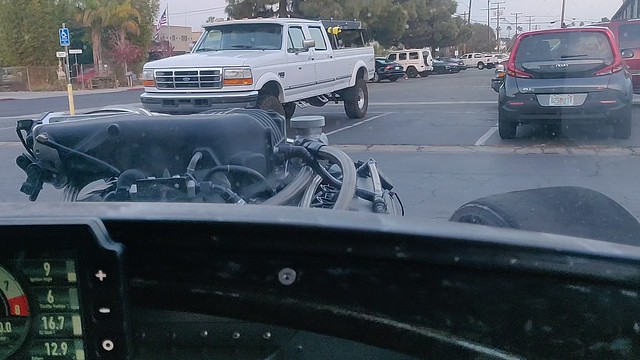

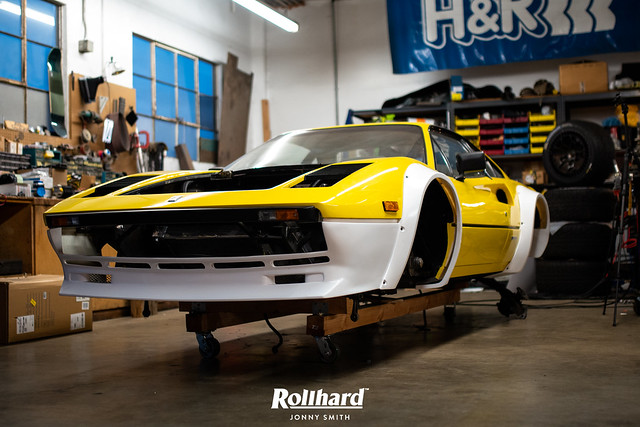
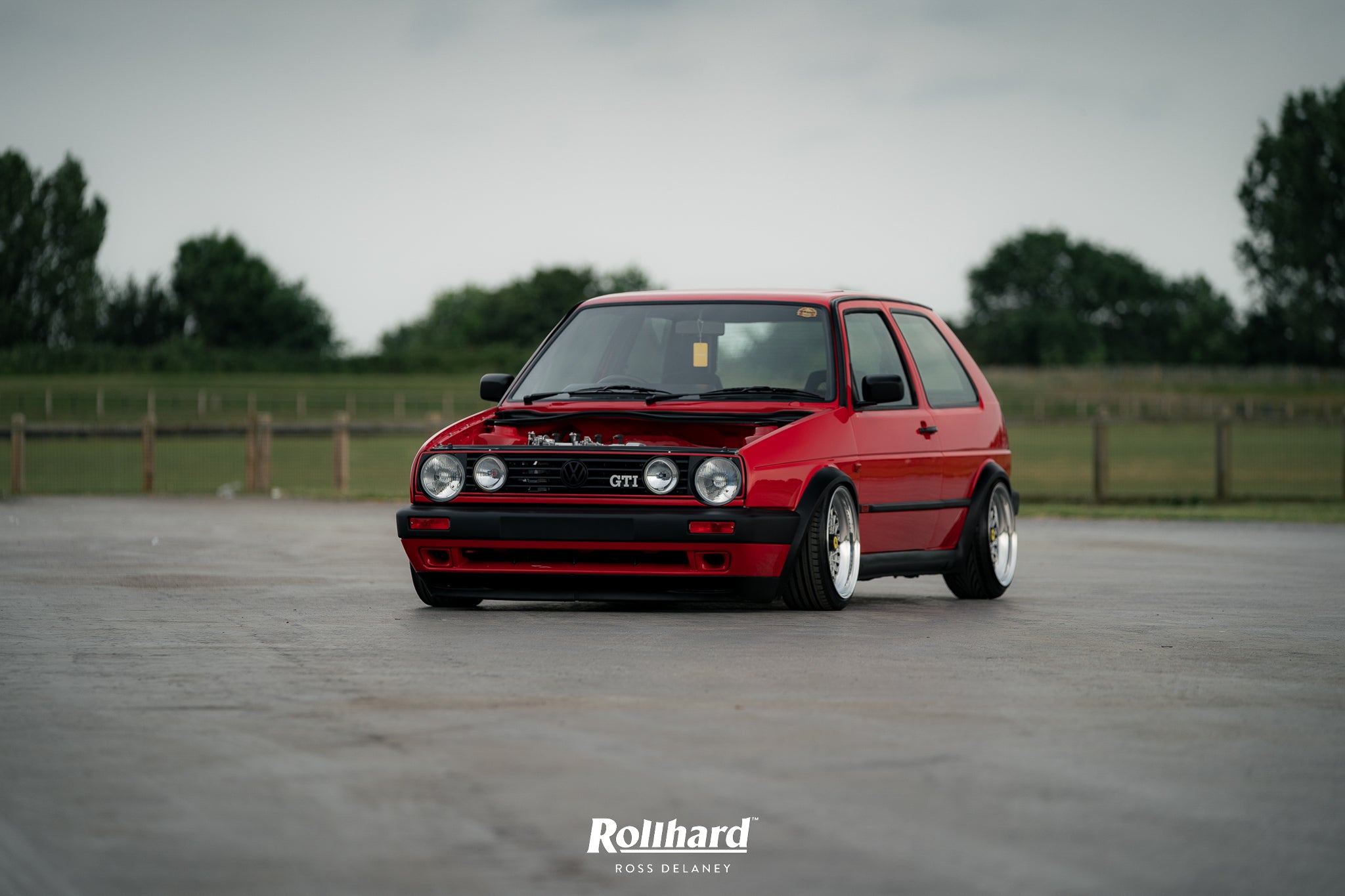
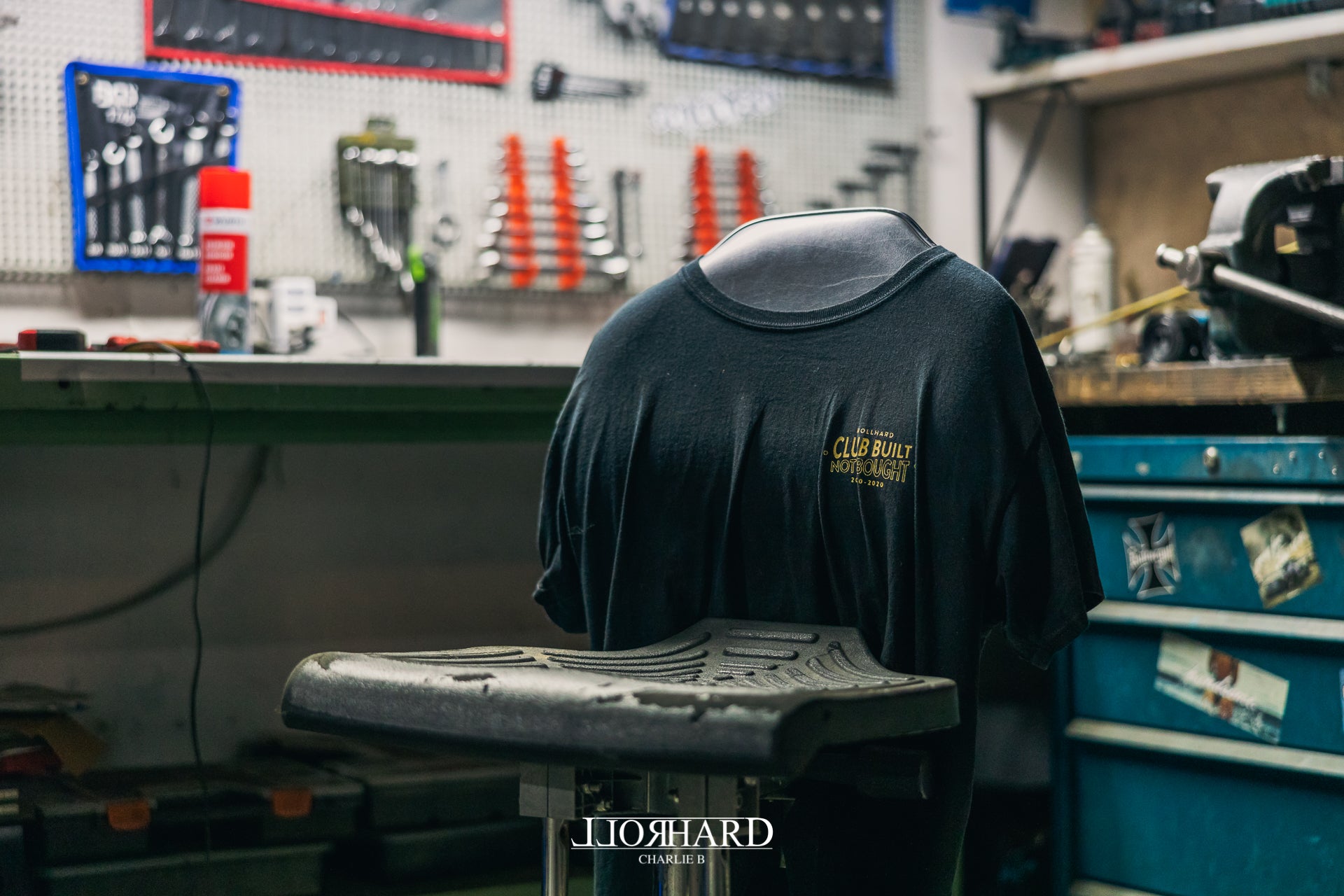
1 comment
FRSHNMNTY
Thanks for the return of the blog, unless I’m looking in the wrong places there seems to be fewer and fewer places with proper articles to read on the web nowadays. The increasing demise of printed car magazines to escape to is making this even more apparent. Aside from speedhunters it’s all photos and videos with minimal written content.
Thanks for the return of the blog, unless I’m looking in the wrong places there seems to be fewer and fewer places with proper articles to read on the web nowadays. The increasing demise of printed car magazines to escape to is making this even more apparent. Aside from speedhunters it’s all photos and videos with minimal written content.